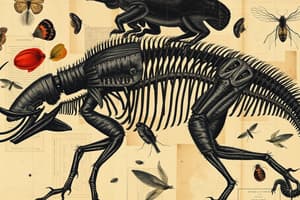Podcast
Questions and Answers
What is the primary purpose of plant taxonomy?
What is the primary purpose of plant taxonomy?
- To promote agricultural practices worldwide.
- To study the evolutionary history of animals.
- To classify and identify plant species based on shared characteristics. (correct)
- To enhance decorative gardening techniques.
Which of the following is classified as a division in plant taxonomy?
Which of the following is classified as a division in plant taxonomy?
- Rosaceae
- Liliopsida
- Angiosperms (correct)
- Magnoliopsida
What is the basic unit of classification in plant taxonomy?
What is the basic unit of classification in plant taxonomy?
- Class
- Family
- Species (correct)
- Genus
Which system of naming species was developed by Carolus Linnaeus?
Which system of naming species was developed by Carolus Linnaeus?
Which method uses genetic sequences for plant identification?
Which method uses genetic sequences for plant identification?
In the classification hierarchy, what comes directly after the family level?
In the classification hierarchy, what comes directly after the family level?
What challenge arises from species hybridization in plant taxonomy?
What challenge arises from species hybridization in plant taxonomy?
Which group of plants does the class Magnoliopsida belong to?
Which group of plants does the class Magnoliopsida belong to?
Flashcards are hidden until you start studying
Study Notes
Botany: Plant Taxonomy
Definition
- Plant taxonomy is the science of naming, defining, and classifying plants based on shared characteristics.
Major Categories
-
Kingdoms
- Plants are classified under the Kingdom Plantae.
-
Divisions (Phyla)
- Major divisions include:
- Bryophyta (mosses)
- Pteridophyta (ferns)
- Gymnosperms (conifers)
- Angiosperms (flowering plants)
- Major divisions include:
-
Classes
- Further splits within divisions, e.g.:
- Class Magnoliopsida (dicots) in Angiosperms
- Class Liliopsida (monocots) in Angiosperms
- Further splits within divisions, e.g.:
-
Orders
- Group related families. E.g., order Rosales includes families like Rosaceae (roses) and Moraceae (figs).
-
Families
- Groups of related genera. E.g.:
- Family Asteraceae (daisies)
- Family Fabaceae (legumes)
- Groups of related genera. E.g.:
-
Genera
- Groups of species that are closely related. E.g.:
- Genus Rosa (roses)
- Genus Quercus (oaks)
- Groups of species that are closely related. E.g.:
-
Species
- The basic unit of classification; consists of individuals that can interbreed and produce fertile offspring. E.g.:
- Rosa rubiginosa (sweet briar rose)
- The basic unit of classification; consists of individuals that can interbreed and produce fertile offspring. E.g.:
Naming Conventions (Nomenclature)
- Binomial Nomenclature:
- Developed by Carolus Linnaeus; each species is given a two-part name:
- Genus name (capitalized)
- Species name (lowercase)
- Example: Homo sapiens (humans)
- Developed by Carolus Linnaeus; each species is given a two-part name:
Tools for Taxonomy
- Field Guides: Reference materials that help identify plants in specific regions.
- Phylogenetics: Studies evolutionary relationships, often depicted in phylogenetic trees.
- DNA Barcoding: Uses genetic sequences to identify and classify plants.
Importance of Plant Taxonomy
- Aids in the identification and classification of plant species, which is essential for:
- Conservation efforts
- Ecological studies
- Agriculture and horticulture
- Pharmacology and medicine
Current Challenges
- Species Identification: Many species remain unclassified or misidentified due to similar physical traits.
- Taxonomic Revisions: Ongoing research may lead to changes in classification as new information emerges.
- Hybridization: Increases complexity in classifying certain plant species.
Study Methods
- Use herbarium specimens for morphological study.
- Engage in fieldwork for practical identification skills.
- Consult taxonomic databases and literature for up-to-date classifications.
Plant Taxonomy
- The science of classifying plants based on shared characteristics.
- Key aspects include naming, defining, and organizing plants into categories.
Major Categories of Plant Classification
- Kingdom Plantae: All plants belong to this kingdom.
- Divisions (Phyla): Broad categories based on major characteristics.
- Bryophyta (Mosses): Non-vascular plants, lack true roots, stems, and leaves.
- Pteridophyta (Ferns): Vascular plants, have roots, stems, and leaves; reproduce via spores.
- Gymnosperms (Conifers): Vascular plants, have cones; produce seeds that are not enclosed in an ovary.
- Angiosperms (Flowering Plants): Vascular plants, have flowers and fruits; produce seeds enclosed in an ovary.
- Classes: Further subdivisions within divisions.
- Class Magnoliopsida (Dicots): Angiosperms with two seed leaves, taproots, and net-veined leaves.
- Class Liliopsida (Monocots): Angiosperms with one seed leaf, fibrous root systems, and parallel-veined leaves.
- Orders: Group related families.
- Rosales: Includes families like Rosaceae (roses) and Moraceae (figs).
- Families: Group related genera.
- Asteraceae (Daisies): Includes sunflowers, daisies, and asters.
- Fabaceae (Legumes): Includes beans, peas, peanuts, and clover.
- Genera: Groups of closely related species.
- Rosa (Roses): Include many varieties of roses.
- Quercus (Oaks): Include various species of oaks.
- Species: The basic unit of classification, individuals that can interbreed and produce fertile offspring.
- Rosa rubiginosa (Sweet Briar Rose): A specific species within the Rosa genus.
Naming Conventions (Nomenclature)
- Binomial Nomenclature: Developed by Carolus Linnaeus.
- Each species has a two-part name:
- Genus name: Capitalized
- Species name: Lowercase
- Homo sapiens (humans) is an example.
- Each species has a two-part name:
Tools for Taxonomy
- Field Guides: Help identify plants in specific regions.
- Phylogenetics: Studies evolutionary relationships, often visualized in phylogenetic trees.
- DNA Barcoding: Uses genetic sequences to identify and classify plants.
Importance of Plant Taxonomy
- Essential for:
- Conservation efforts
- Ecological studies
- Agriculture and horticulture
- Pharmacology and medicine
Current Challenges
- Species Identification: Many species remain unclassified or misidentified due to similar physical traits.
- Taxonomic Revisions: Ongoing research may lead to changes in classification as new information emerges.
- Hybridization: Increases complexity in classifying certain plant species.
Study Methods
- Use herbarium specimens for morphological study.
- Engage in fieldwork for practical identification skills.
- Consult taxonomic databases and literature for up-to-date classifications.
Studying That Suits You
Use AI to generate personalized quizzes and flashcards to suit your learning preferences.




